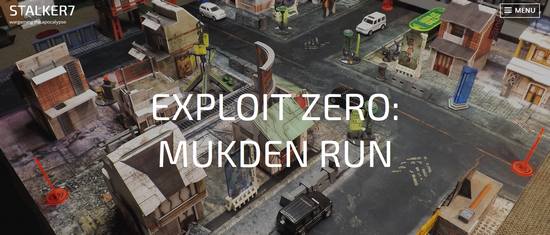An urban camouflage for Northern Guard units... where to start?
DP9 has some example camo schemes on their website, so for a completist's approach, I'll use one of these for reference. The 'City' Pattern Breaker is one choice, although I think it's a little uninspired... so I'll go instead for the 'Urban' scheme, as used on DP9's display Assault Mammoth. The Mammoth is in brown, possibly for an operation in a Badlands theatre, but in the ESE the majority of urban centres are built from igneous basalt rock, characterised in description by its dark colour. This suggests to me that a dark-to-mid blue-grey scheme would work best.

After priming, the base coat is applied by airbrush; it's not by any means essential, but if you happen to have an airbrush lying around (I also do a lot of larger-scale kit modelling), it's an excellent quick-and-easy way of applying your basecoat in an even and relatively thorough manner.
I'm using Tamiya acrylics for this, for two reasons. Firstly, they're non-toxic and thinned easily with alcohol - secondly, simply because in my experience it's practically impossible to get airbrushing Tamiya acrylics wrong, they seem to be formulated out of some special liquid that magically rights any thinning or mixing problems before they get to the brush. I'm using a shade pretty much identical to Sea Blue for my basecoat, but annoyingly, Tamiya only offer the full range of colours as part of their flat (matt) range, and since I'll be using washes later, it's unwise to use these; flat Tamiya paints soak up washes and stain rather than allow the wash to settle in the recesses, so I'll mix my own from gloss bottles: three-parts gloss white, one-part gloss black, and one-part gloss blue.
I always throw half a pizza box onto my workbench when I'm airbrushing; I'm pointing the 'brush downward, but it's still good to have a lip around the surface to catch the majority of the overspray. You're never going to catch all of it, but it gives me an excuse to eat more pizza than I really ought to.

Each set of successively-lighter squares is painted on in turn, taking up successively less space. First, the outlines are painted with a fine brush, then the areas filled with a larger one. The little crosses are stolen from comics-inking; they help the eye to notice areas that have yet to be filled in (it's surprisingly easy to forget one or two...)
Colours used are all stock paints - because I might want to paint up a whole regiment in the same camo, I don't want to be mixing custom colours all the time. All Citadel paints - from the dark up, they're Shadow Grey, Codex Grey and Fortress Grey.

Finally, detail colours are painted - here, this just means metal parts (I figure actual tanks - and thus gears - probably wouldn't actually have so much bare metal in the field, but... well, it looks good, and again, helps distinguish one model of gear from another) and the wheels of the SMS.

Next, the decals are applied. If you apply the decals last, they look too shiny and clean compared to the weathered and shaded surfaces, so they need to go on before any of the shading happens. I'll paint the area the decal goes on with Future Floor Acrylic to make sure the decal has a good surface to sit on, and use a little MicroSol to conform the decal to the surface of the mini. (Future is an acrylic-based floor varnish, sold to make your kitchen floor shine - it's well known amongst kit modellers to be a good gloss varnish that's significantly cheaper than aerosols.) I'm told a vinegar solution or other light acids work just as well (and are cheaper than) MicroSol, but I still have most of a bottle so I've never had occasion to try it.
After all the decals are affixed, the figure is given a light coat of varnish to stop them floating around in the impending washes...








